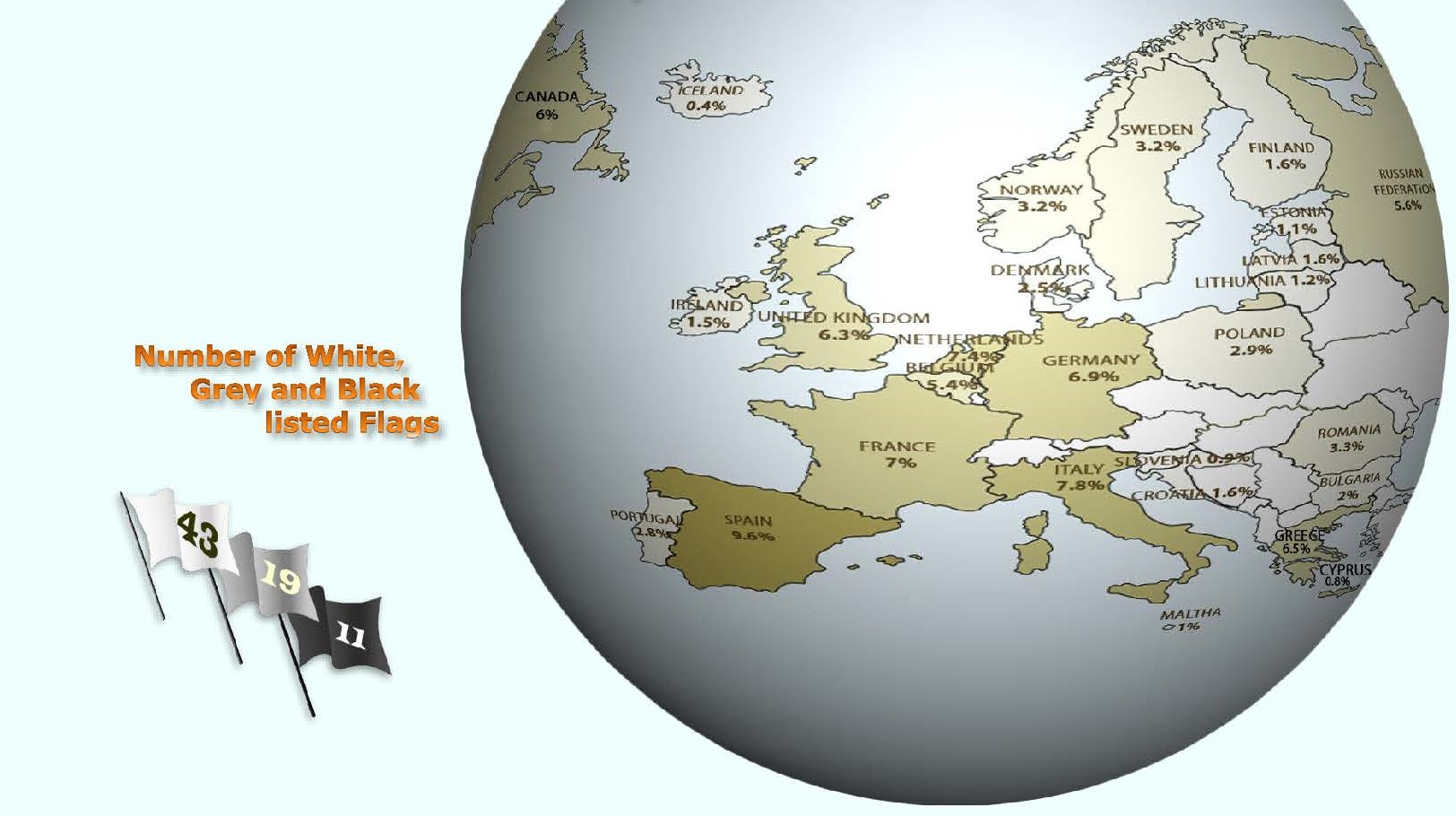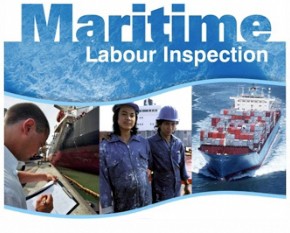CIC on MLC, 2006 has achieved its goal of creating more awareness
Port State Control Officers in the Paris MoU region have performed a Concentrated Inspection Campaign (CIC) on Maritime Labour Convention (MLC), 2006 in the period from 1 September to 30 November 2016. The aim of the CIC was to verify that the minimum standards for working and living conditions have been implemented on board and thereby creating more awareness.
Secretary General Richard Schiferli states: “Good working and living conditions on board will contribute to create a positive crew attitude towards safety onboard. That is why the MLC will always be a prime area of attention. The Paris MoU is satisfied with the overall result”.
A total of 3674 questionnaires for the CIC have been completed during regular inspections. The campaign resulted in 42 detentions (1.1%) directly linked to the MLC, 2006 requirements.
Positive results were recorded on certificates attesting medical fitness (98.2%), the verification of records of the inspections of the accommodation (98%), food and catering (97.4%), and whether a safety committee has been established (99.1%).
Less positive results on non-compliance were recorded on Seafarers Employment Agreements not being compliant with minimum standards (6.5%) and the availability of the onboard complaint procedure (5%).
Most of the 3674 ships inspected during the CIC were general cargo/multi-purpose ships, 1062 (28.9%) inspections and bulk carriers with 789 (21.5%) inspections.
Most of the 3674 CIC inspections carried out on board ships were flying the flags of Panama with 433 (11.8%) inspections, Malta with 328 (8.9%) inspections and Liberia with 314 (8.5%) inspections.
The results of the campaign will be further analysed and findings will be presented to the Port State Control Committee. The final CIC report will be published on the Paris MoU website.
THE PARIS MOU MARKS ITS 35TH ANNIVERSARY BY HOLDING ITS 50TH MEETING IN GDANSK, POLAND
The Paris Memorandum of Understanding on Port State Control (Paris MoU) held its 50th Committee meeting in Gdansk, Poland, from the 22nd to the 26th May 2017, this special meeting was chaired by Mr. Brian Hogan. During the meeting, member States also commemorated the Paris MoU 35th anniversary and 25th anniversary of Poland being a member of the organization.
The Paris MoU welcomed the “Ministerial Declaration” signed during the 3rd Joint Ministerial Conference between the Paris and Tokyo MoUs held in Vancouver earlier this month. Secretary General Richard Schiferli expressed the view of the Committee that the declaration demonstrates that the Paris MoU and Tokyo MoU members agree on the importance to safeguard responsible and sustainable shipping in order to further enhance safety, environmental protection and working and living conditions for seafarers. The declaration will provide political support to undertake port State control initiatives between the two regions.
The methodology for calculating flag and recognized organization (RO) performance, used for the targeting of ships for inspection, is being reviewed. The Committee agreed to move towards a new scheme to replace the current White-Grey-Black List and RO performance List in the near future.
High importance was given to the report of the Concentrated Inspection Campaign (CIC) on MLC, 2006. The CIC was carried out from September to November 2016. The general conclusion was that the results show a proper implementation of the MLC requirements on board the ships inspected, and compliance on the MLC areas focused on in the questionnaire.
The Committee approved the questionnaire for the CIC on Safety of Navigation to be carried out jointly with the Tokyo MoU. The CIC aims at checking the compliance with Safety of Navigation, including Electronic Chart Display Information Systems (ECDIS). The CIC will be carried out from September to November 2017 and the questionnaire will be published in August.
The Committee took decisions in relation to the sustainability of shipping, including the Polar Code, Ballast Water Management and air emissions from ships.
The Committee adopted the 2016 Annual Report, including the White, Grey and Black List and the performance list of recognized organizations. The lists will be published in early June and used for targeting purposes from 1 July 2017. The Annual Report will be published by the end of July this year. The number of ships which have been refused access to the Paris MoU region after multiple detentions has increased from 11 to 20. Five ships have been refused access for the second time. This demonstrates the effectiveness of the New Inspection Regime. The Committee noted that the detention percentage has increased from 3.3% to 3.8%.
The Committee re-elected Mr. Brian Hogan (Ireland) as Chairman and elected Mr. Naim Nazha (Canada) as vice-Chairman.
The meeting was attended by members of the Paris MoU, the European Commission, EMSA, Montenegro, observers from the International Labour Organization, US Coast Guard, Tokyo MoU, Caribbean MoU, Mediterranean MoU, Black Sea MoU and Indian Ocean MoU.
On behalf of the member Authorities, Mr. Hogan concluded the meeting by remarking that significant progress has been made on port State control issues during this meeting. He thanked all member Authorities, the European Commission, EMSA and the Paris MoU Secretariat for their contribution. In particular Mr. Hogan thanked the Maritime Authority of Poland, for the excellent arrangements they made for this Committee meeting.
Results of CIC Hours of Rest 2014
The Paris MoU on Port State Control carried out a joint Concentrated Inspection Campaign (CIC) with the Tokyo MoU on Port State Control on Hours of Rest (STCW) between 1 September and 30 November 2014. During the campaign, 27 Paris MoU and 17 Tokyo MoU member states focussed on compliance with the requirements regarding hours of rest as per STCW 78, as amended, on inspected ships. This report documents the results of the campaign for the Paris MoU Maritime Authorities. Results for the Tokyo MoU Maritime Authorities are documented separately.

2011 Annual Report "On course for safer shipping"
2011 Annual Report (dynamic version)
This year was one of the most significant and busy years for the Paris MoU in recent times. The start of the year saw the introduction of the New Inspection Regime (NIR) which has transformed and modernised the port state control regime in our region. The introduction of the NIR was the culmination of many years hard work by very many people. All of those who took part in this work, including the various task forces and groups which developed the NIR, are to be complimented on their achievement. Alongside the NIR we also introduced our new information system called “THETIS”. Again I would like to thank all of those involved with this. More details of the implementation of the NIR and “THETIS” are contained in this annual report together with the updated statistical tables which reflect the implementation of the NIR...
2012 Paris Mou Annual "Taking Port State Control to the Next Level"
2012 Annual Report (dynamic version)
The year 2012 started out with maritime safety in the headlines of the world’s news with the grounding of the “M/V Costa Concordia”. This event was a shock to the Paris MoU and should be taken as a sign to increase our efforts on verifying the safety of all ships operating in our waters. I wish to extend my sympathy and that of the Paris MoU to all the families of those touched by this tragedy. While the casualty report will detail the lessons to be learnt, the Paris MoU considered that the issue of cruise ship safety should be addressed. With this in mind the Paris MoU developed a harmonized inspection campaign for cruise ships during 2012 to commence from the 1st of January 2013.
2015 Paris MoU Annual Report “Safer entry of enclosed spaces”
2015 Annual Report on Port State Control (Dynamic version)
“Safer entry of enclosed spaces”
2015 shows a large decrease in the refusal of access (“bans”) within the region: 11 bans compared to 20 in 2014. The detention percentage has remained stable at 3.33%. The number of deficiencies has decreased 10% related to 2014. The number of inspections carried out was 17,858, slightly less than 2014 (18,430). Over a 3-year period of time, most cases of refusal of access involve ships which have been banned for multiple detentions (45). 5 ships have been banned a second time. A significant number (12) were banned for failing to call at an indicated repair yard. The remaining 3 cases involved ships which “jumped the detention”, by sailing without authorization. Over a 3 year period the flags of the United Republic of Tanzania, the Republic of Moldova, Saint Vincent and the Grenadines and Togo have recorded the highest number of bannings.
Looking at the Paris MoU “White, Grey and Black Lists” the overall situation regarding the quality of shipping seems to be stabilizing. Although individual flags have changed lists, the total amount of 43 flags on the “White list” is equal to 2014.
Sweden is leading this year’s list, followed by the United Kingdom and France. This year Portugal and Spain have moved from the “Grey List” to the “White List”. India and Switzerland moved from the “White List” to the “Grey List”. Saint Kitts and Nevis moved from the “Grey List” to the “Black List”. In 2015 there are 11 flags on the “Black List”, with the United Republic of Tanzania having the worst performance for the third year in a row.
Recognized Organizations (ROs) are delegated by flag States to carry out statutory surveys on their behalf. For this very reason, it is important to monitor their performance. The best performing RO over the period 2013-2015 was DNV GL, followed by Det Norske Veritas (DNV) and American Bureau of Shipping (ABS)*.
International Register of Shipping is bottom of the list in 2015, in terms of poor performance, followed by Universal Shipping Bureau Inc and Bulgarian Register of Shipping. For several years a joint submission with the Tokyo MoU to IMO has addressed the correlation between flags and ROs working on their behalf. The results are published in the Annual Report as well. Useful information for the industry that would like to stay clear of the risk of sub standard shipping.
After an increase of the total number of inspections in 2014, the number has slightly decreased. Since 2011 (the start of the NIR) the average detention percentage had slightly increased annually until 2013 (3.78%), after which a significant decrease has been recorded for 2014 (3.32%). In 2015 the detention percentage remained stable at 3.33%. Spain, Italy, the Netherlands, France, Germany, Greece and the United Kingdom contributed most to the overall inspection efforts in terms of percentage, together over 51%. High Risk Ships have been operating mostly in the southern part of the region, while Low Risk Ships have been calling in the north-western part of the region.
With 1,166 inspections and 131 detentions the ships flying a “black listed flag“ score a detention rate of 11.23%, which is similar to 2014 and 2013. For ships flying a “grey listed flag” the detention rate is 8.58%, which is significantly higher than 2014 (6.27%). For ships flying a “white listed flag” the detention rate is 2.50% which is at the same level as 2014.
The 5 most frequently recorded deficiencies in 2015 were “ISM” (4.3%, #1797), “fire doors/openings in fire-resisting divisions” (2.5%, #1044), “nautical publications” (2.5%, #1016), “charts” (2.4%, #996) and “oil record book” (1.6%, #645).
The full 2015 Annual Report has been published on www.parismou.org.
2015 Performance lists Paris MoU

Agreed performance lists Paris MoU
At its 49th meeting last month, the Paris MoU Committee approved the 2015 inspection results and adopted new performance lists for flags and Recognized Organizations. These lists will take effect from 1 July 2016.
The “White, Grey and Black (WGB) List” presents the full spectrum, from quality flags to flags with a poor performance that are considered high or very high risk. It is based on the total number of inspections and detentions over a 3-year rolling period for flags with at least 30 inspections in the period.
On the “White, Grey and Black list” for 2015, a total number of 73 flags are listed: 43 on the “White List”, 19 on the “Grey List” and 11 on the “Black list”. In 2014 the number of flags listed totalled 72 flags, namely 43 on the “White List”, 19 on the “Grey List” and 10 on the “Black List”.
The “White List” represents quality flags with a consistently low detention record. Compared with 2014, the number of flags on the “White List” remains the same. New on the “White List” are Portugal and Spain, which were on the “Grey List” last year.
Sweden has been placed highest on the list in terms of performance this year. The next in line of the best performing flags in 2015 are the United Kingdom, France, Denmark and Norway.
Flags with an average performance are shown on the “Grey List”. Their appearance on this list may act as an incentive to improve and move to the “White List”. At the same time flags at the lower end of the “Grey List” should be careful not to neglect control over their ships and risk ending up on the “Black List” next year.
On this year’s “Grey List” a total number of 19 flags is recorded. Last year the “Grey List” also recorded 19 flags. New on the “Grey List” are India and Switzerland, which last year were on the “White List”.
Saint Kitts and Nevis has fallen from the “Grey List” to the “Black List”. The poorest performing flags are the United Republic of Tanzania, Republic of Moldova, Togo, Comoros and Cook Islands.
For several years the Committee has closely monitored the performance of classification societies acting as ROs for flags. To calculate the performance of the Recognized Organizations, the same formula to calculate the excess factor of the flags is used. A minimum number of 60 inspections per RO is needed before the performance is taken into account for the list. In 2015 43 ROs are recorded on the performance list.
Among the best performing Recognized Organizations were:
- DNV GL AS (DNVGL),
- Det Norske Veritas (DNV),
- American Bureau of Shipping (ABS),
- Lloyd’s Register (LR),
- Korean Register of Shipping (KRS).
The lowest performing Recognized Organizations were:
- International Register of Shipping (IS),
- Universal Shipping Bureau Inc (USB),
- Bulgarian Register of Shipping (BRS).
Compared with last year’s performance level, a small shift in RO performance in 2015 can be noticed. This year even fewer organisations have been placed in the very low (1) and low performing parts (1) of the list and more ROs have been placed in the medium part of the list.
Details of the responsibility of Recognized Organizations for detainable deficiencies have been published since 1999. When one or more detainable deficiencies are attributed to a Recognized Organization in accordance with the criteria, it is recorded “RO responsible” and the RO is informed. Out of 595 detentions recorded in 2015, 74 or 12.4% were considered RO related.
On 1 July 2016 the performance lists will be used for calculating the ship risk
profile and flags on the “Grey List” and “Black List” are subject to the more
stringent banning measures in force since 1 January 2011. More information can be found in the 2015 Annual Report, which will be released in July 2016. The lists are also published on the Paris MoU website.
PARIS MOU AGREES ON A CONCENTRATED INSPECTION CAMPAIGN ON MARPOL ANNEX VI IN 2018
The Paris Memorandum of Understanding on Port State Control (Paris MoU) held its 49th Committee meeting in Haugesund, Norway. Mr. Brian Hogan chaired the meeting, held from 23 - 27 May 2016. The meeting was officially opened by the State Secretary Mrs. Dilek Ayhan of Norway. High importance was given to the Concentrated Inspection Campaign (CIC) on MLC, 2006 which is scheduled from September to November this year. Living and working conditions for seafarers continue to be a priority.
Results first month Maritime Labour Convention: 7 ships detained for MLC-related deficiencies

Results first month Maritime Labour Convention: 7 ships detained for MLC-related deficiencies
14 October 2013
On 20 August 2013 the Maritime Labour Convention (MLC, 2006) entered into force and became a relevant instrument for the Paris MoU. Thus making the MLC requirements officially subject to port State control. During the first month 7 ships were detained for MLC-related deficiencies. This means that 10% of the total number of detentions (68) in the Paris MoU area in this period was MLC, 2006 related.
The detentions were imposed by 4 different port States: Canada (2 ships), Denmark, the Russian Federation and Spain (3 ships). The detained ships were flying the flag of Cyprus (2 ships), Liberia, the Netherlands, Panama (2 ships) and Tanzania.
Other interesting figures during the month of MLC:
- A total of 4,260 deficiencies have been recorded;
- 494 deficiencies out of the 4,260 recorded (11.5%) were related to any of the ILO Conventions listed as relevant instrument;
- Of these 494, 30 (6,1%) were considered to be serious enough to be a ground for detention;
- 23 of those 30 (76,7%) were related to breaches of the MLC and resulted in the detention of 7 individual ships;
- The total number of detentions was 68 during 1,532 inspections, which resulted in a detention rate of 4,4%.
The MLC, 2006 applies to all ships engaged in commercial activities. International certification is required for all ships of 500GT and over, making international voyages. The requirements of the MLC, 2006 have to be implemented on board at the entry into force date 20 August 2013.
Only the member States of the Paris MoU who have ratified the MLC,2006 on or before 20 August 2012 are entitled to conduct PSC inspections on MLC, 2006 requirements from 20 August 2013. As a result the following twelve member States have started enforcing the MLC, 2006: Bulgaria, Canada, Croatia, Cyprus, Denmark, Latvia, the Netherlands, Norway, Poland, the Russian Federation, Spain and Sweden.
